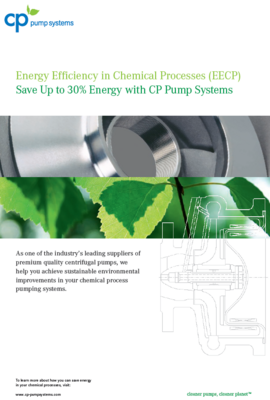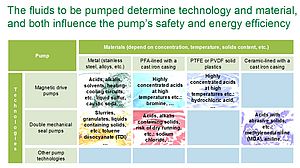Pumping systems are designed to meet many requirements, but seldom that of energy efficiency As a result, some plants are built with poor system design where pumps are inappropriately matched to the system, pipe diameters are incorrectly selected and system flow velocities are too high. Bad plant layout and the consequential inefficient routing of pipes frequently exacerbate the situation as well. All these factors increase frictional resistance so larger pumps than would otherwise be necessary are needed to deliver liquid to the required service.
Systems already in place
Changing a running system already in place is often very difficult. Partial modifications are sometimes made to pumps, valves and measuring instruments, for example to optimize the system's available net positive suction head (NPSH), gather measurement information or change suction and/or discharge flanges when replacing pumps with new ones of different sizes. Due to the heavy expenditure for engineering and materials, modifications are often limited in size and scale and, at best, usually have just a minor impact on the energy efficiency of a given system.
One significant exception is to consider variable speed pumping solutions that can be retrofitted to a system already in service. Another viable option is to check whether any duty points can be subsequently rescaled, because each system is designed with safety margins added to the calculated system curves to ensure that sufficiently large pumps are selected for the job. As a result, the pumps installed are often oversized and then operate at excessive flow rates or in throttled conditions, increasing energy usage and reducing pump life.
Planning new pumping systems
Competent planning of new pumping systems to minimize energy consumption is one of the keys to reducing system life cycle costs (LCC). Some energy use may not be output-dependent. For example, a control system sensing output changes may itself generate a constant energy load, whereas a variable speed drive may consume different levels of energy at different operating settings. Throttling valves, pressure reliefs and flow bypasses used for control will all reduce operating efficiency and increase energy consumption. Additional costs may come from cooling or heating circuits, liquid flush lines or fluid barrier arrangements. While such costs often do not vary for different types of systems, they can be influenced by selection of different materials or designs.
Carefully selected pumping systems will reduce your energy costs. If pumps can be optimally matched to the system in an early stage, if variable speed drives are considered for each position where they will help reduce energy consumption, if pipe diameters and distances are correctly selected and if flow velocities are optimal, then a system's overall frictional resistance can be minimized, thereby maximizing the monetary savings over the system's lifetime. This is why CP offers you individually tailored advice during your pumping system planning to find exactly the right solution for every pumping need - around the globe.


















